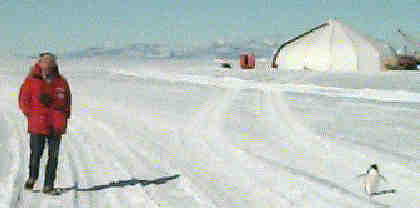
Hi Kaley,
I am 42 years old, but I sometimes feel like I am 10. At Christmas time, I am just an old kid. That is why I am very glad that I will be returning home in time for Christmas. I will be coming back to the ice in January for about 10 months.
I like it here, but it is still a new adventure. I hope that this journey keeps my interest. I do not have any problems with sleeping when it is light out, but I do have problems with time. It is confusing at times because of the light all the time. Right now in Delmar, if the clock says 9 o'clock, and it is light out, you know it is morning.

Nobody has gotten hurt while I have been here, but there have been many injuries and deaths over the years. This is a very dangerous place. One important thing here, is you must take care of your body and drink lots of fluids. You can become sick quickly from a lack of water. Although it is cold, this is a desert, and the humidity is usually about 10%. They gave me a water bottle which I carry everywhere. Another danger is the crevasses in the ice. It is very important when going for a walk to always walk in pairs on marked paths. The ice fields can have hidden holes going down very far. There have been people who have fallen in these and died in past years.
The most exciting thing so far is a walk I had down the road to Scott Base, which is where the New Zealand Kiwi's have a town. Although the McMurdo Sound is frozen for as far as you can see, there is an iceberg in the sound near Scott Base, with some pressure ridges in the ice. The pressure ridges push up ice, and allow some holes in the ice. There were some seals laying on the ice near the ridges. I hope to walk closer next weekend, but I must attend a school on safety before going out on the ice. Also you must not bother any of the wildlife here, by getting too close. Thanks for writing,
Dave
Hi Nickel,
I agree, you have too many Ashleys at your school. I meet several Ashleys when I visited there. I understand the problem, as my name is Dave, and out of the 7 people we have working in our group, there are 3 Daves. It is very confusing.

The last plane ride I had was the 6th plane it took to get here. The landing was the softest I had the entire trip. I did not even know we were on the ground until someone looking out the window gave me a thumbs up. The runway they used to land will only be open for a few more weeks. At that time, the ice will start to break up, and then supply ships will start coming into McMurdo. There is another air field that is on permanent ice that never melts. It is about 12 kilometers from here.
I am not afraid of the volcano, but it is a cause for concern. Mount Erebus is an active volcano on the island where I am staying. It is many miles away, but I can see it from the station where I work. I took a picture today of the volcano, as the wind was just right that I could see a big plume of steam coming out the top. There are scientists here, that just happen to be in the next office, that constantly monitor the activity. I hope that being next door, I will be one of the first people to find out about any problems.
I have heard the activity is very minimal, and it is only venting steam. I dress in a very similar fashion to the winters in Delmarva, but this is summer time here. Keep in mind, I am usually only walking between buildings, and the weather has been mild. On the plane ride down, we must wear a full set of cold weather gear. I wore long underwear tops and bottoms, then put on what looked like bib overalls that were made of a heavy thermal material. I then wore a heavy nylon overall or wind pants. On my feet I wore heavy wool socks, with big special boots. I wore a polar fleece jacket, a polar fleece hat with ear flaps, a huge down coat, and 2 pairs of mittens. They require all the clothes on the plane, because if there was a problem we must be warmly dressed.
It is very interesting here. I have meet many people in different professions. At this time of year, there are many scientists doing research on everything from soil organisms to meteorites.
Thanks for writing,
Dave
David Hess NK3T